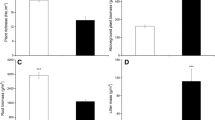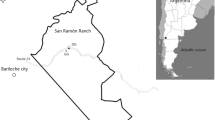Abstract
Grassland degradation is widespread and severe on the Tibet Plateau. To explore management approaches for sustainable development of degraded and restored ecosystems, we studied the effect of land degradation on species composition, species diversity, and vegetation productivity, and examined the relative influence of various rehabilitation practices (two seeding treatments and a non-seeded natural recovery treatment) on community structure and vegetation productivity in early secondary succession. The results showed: (1) All sedge and grass species of the natural steppe meadow had disappeared from the severely degraded land. The above-ground and root biomass of severely degraded land were only 38 and 14.7%, respectively, of those of the control. So, the original ecosystem has been dramatically altered by land degradation on alpine steppe meadow. (2) Seeding measures may promote above-ground biomass, particularly grass biomass, and ground cover. Except for the grasses seeded, however, other grass and sedge species did not occur after seeding treatments in the sixth year of seeding. Establishment of grasses during natural recovery treatment progressed slowly compared with during seeding treatments. Many annual forbs invaded and established during the 6 years of natural recovery. In addition, there was greater diversity after natural recovery treatment than after seeding treatments. (3) The above-ground biomass after seeding treatment and natural recovery treatment were 114 and 55%, respectively, of that of the control. No significant differences in root biomass occurred among the natural recovery and seeded treatments. Root biomass after rehabilitation treatment was 23–31% that of the control.


Similar content being viewed by others
References
Deng ZF, Zhou XM (2001) Reproductive strategies of major plant populations in Kobersia meadow. In: Zhou XM (ed) Chinese kobersia meadow. China Science Press, Beijing, pp 95–130
Hammermeister AM (2001) An ecological analysis of prairie rehabilitation on petroleum well-sites in southeast Alberta. PhD Thesis, University of Alberta. ProQuest Information and Learning (UMI), Ann Arbor
Li WH, Zhou XM (1998) Ecosystems of Tibetan Plateau and approach for their sustainable management. Guangdong Science and Technology Press, Guangdong
Li YF, Lai DZh, Zhou MX (1999) Rat and insect controls in grassland of Guoluo prefecture. Chin Qinghai J Anim Vet Sci 29(4):16–17
Liu W, Wang QJ, Zhou L (1999) Ecological process of forming “Black-Soil-type” degraded grassland. Acta Agrestia Sin 7(4):300–307
Ma YSH (1999) Review and prospect of the study on “Black Soil Type” degraded grassland. Pratacultural Sci 16(2):5–8
Poole RW (1974) An introduction to quantitative ecology. McGraw-Hill Inc., New York
Sun HL, Zheng D (1998) Formation, evolution and development of Qinghai–Xizang (Tibetan) Plateau. Guangdong Science and Technology Press, Guangdong
The Livestock Husbandry Programming Office of Qinghai Province (1987) The sources and programme of livestock husbandry in qinghai province. Sichuan Scientific and Technical Press, Sichuan
Wang QJ (1997) The study of grassland resource, ecological environment and sustainable development on Qinghai–Tibet Plateau. Qinghai Prataculture 6(3):1–11
Wang QJ (2001) Biomass and productive mechanism of Kobersia meadow. In: Zhou XM (ed) Chinese kobersia meadow. China Science Press, Beijing, pp 131–167
Wang GX, Cheng GD (2001) Characteristics of grassland and ecological changes of vegetations in the sources regions of Yangtze and Yellow rivers. J Desert Res 21(2):101–107
Zhou XM, Li YN (2001) Ecological conditions affecting Kobersia meadow. In: Zhou XM (ed) Chinese kobersia meadow. China Science Press, Beijing, pp 1–23
Zhou XM, Wang ZHSH, Du Q (1987) Qinghai vegetation. Qinghai People Press, Xining
Acknowledgements
This research was supported by China’s National “Tenth Five-Year” Scientific and Technological Key Programme (no. 2001BA606A-2). We thank Shi Huilan for her help collecting samples.
Author information
Authors and Affiliations
Corresponding author
About this article
Cite this article
Wang, W., Wang, Q. & Wang, H. The effect of land management on plant community composition, species diversity, and productivity of alpine Kobersia steppe meadow. Ecol Res 21, 181–187 (2006). https://doi.org/10.1007/s11284-005-0108-z
Received:
Accepted:
Published:
Issue Date:
DOI: https://doi.org/10.1007/s11284-005-0108-z




